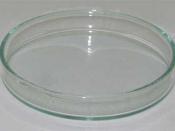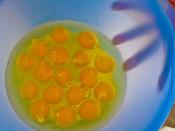The effects of osmosis on potatoes placed in different salt concentration
Introduction:
Osmosis is a movement of water across a semi-permeable membrane. This may only happen when there is a difference in concentration between the two sides of the membrane. The water moves from low concentrations to high concentrations. That is because the low concentrated area tries to dilute the opposite via osmosis.
The effects osmosis has on a cell are either that it becomes turgid and hard as water enters the cell or it becomes dehydrated (this is called plasmolysing in plant cells) as water leaves the cell and the solution enters. There is a change of mass, volume, texture and length.
Aim:
The aim is to investigate the effects of varying concentrations of a salt solution on the amount of osmotic activity between the solution and a potato of a given size.
Osmosis:
Process of Osmosis
Osmosis is the process of the flow of one constituent of a solution (in this case salt) through a membrane while the other constituents are blocked and unable to pass through the membrane.
Experimentation is necessary to determine which membranes permit selective flow, or osmosis, because not all membranes act in this way. Many membranes allow all or none of the constituents of a solution to pass through; only a few allow a selective flow. That is why I have chosen potatoes as my semi-permeable membrane.
In osmosis, a solvent (often water) moves from a region of low concentration to a region of high concentration through a semi-permeable membrane. Here, water molecules diffuse into the concentrated salt solution because the water molecules are small enough to move through the semi permeable membrane. The larger salt molecules are unable to move through the membrane into the water solution because the...



Wonderful
Very useful osmosis essay which all OCR GCSE students would find helpful in writing their own.
1 out of 1 people found this comment useful.